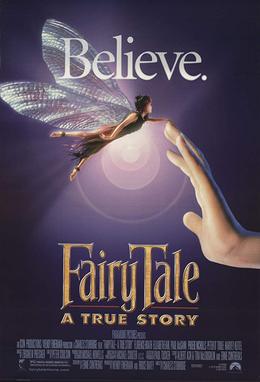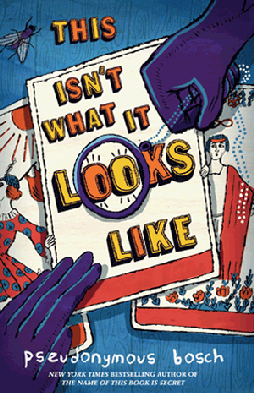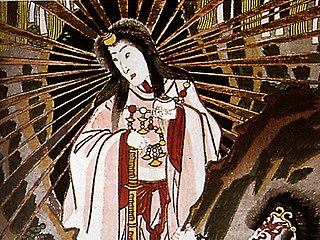
The Castle of Otranto is a novel by Horace Walpole. First published in 1764, it is generally regarded as the first gothic novel. In the second edition, Walpole applied the word 'Gothic' to the novel in the subtitle – A Gothic Story. Set in a haunted castle, the novel merged medievalism and terror in a style that has endured ever since. The aesthetic of the book has shaped modern-day gothic books, films, art, music, and the goth subculture.

Melmoth the Wanderer is an 1820 Gothic novel by Irish playwright, novelist and clergyman Charles Maturin. The novel's titular character is a scholar who sold his soul to the devil in exchange for 150 extra years of life, and searches the world for someone who will take over the pact for him, in a manner reminiscent of the Wandering Jew.

FairyTale: A True Story is a 1997 fantasy drama film directed by Charles Sturridge and produced by Bruce Davey and Wendy Finerman. It is loosely based on the story of the Cottingley Fairies, and follows two children in 1917 England who take a photograph soon believed to be the first scientific evidence of the existence of fairies. The film was produced by Icon Productions and was distributed by Paramount Pictures in the United States and by Warner Bros. internationally.

Ghost Ship is a 1952 British second feature thriller film directed by Vernon Sewell and starring Dermot Walsh and Hazel Court. It was written by Vernon Sewell and Philip Thornton. This was one of four attempts by Vernon Sewell to adapt and film the Pierre Mills and Celia de Vilyars Grand Guignol stage playL'Angoisse.
The Castle of Wolfenbach (1793) is the most famous novel written by the English Gothic novelist Eliza Parsons. First published in two volumes in 1793, it is among the seven "horrid novels" recommended by the character Isabella Thorpe in Jane Austen's novel Northanger Abbey and an important early work in the genre, predating Ann Radcliffe's The Mysteries of Udolpho and Monk Lewis's The Monk.
Dear creature! How much I am obliged to you; and when you have finished Udolpho, we will read The Italian together; and I have made out a list of ten or twelve more of the same kind for you.
Have you, indeed! How glad I am! What are they all?
I will read you their names directly; here they are, in my pocketbook. Castle of Wolfenbach, Clermont, Mysterious Warnings, Necromancer of the Black Forest, Midnight Bell, Orphan of the Rhine, and Horrid Mysteries. Those will last us some time.
Yes, pretty well; but are they all horrid, are you sure they are all horrid?
The Necromancer; or, The Tale of the Black Forest is a Gothic novel written by Karl Friedrich Kahlert under the alias Lawrence Flammenberg and translated by Peter Teuthold that was first published in 1794. It is one of the seven 'horrid novels' lampooned by Jane Austen in Northanger Abbey. It was once thought not to exist except in the text of Northanger Abbey.

This is a bibliography of works by Mary Shelley, the British novelist, short story writer, dramatist, essayist, biographer, and travel writer, best known for her Gothic novel Frankenstein: or, The Modern Prometheus (1818). She also edited and promoted the works of her husband, the Romantic poet and philosopher Percy Bysshe Shelley. Until the 1970s, Mary Shelley was known mainly for her efforts to publish Percy Shelley's works and for Frankenstein. Recent scholarship has yielded a more comprehensive view of Mary Shelley’s achievements, however. Scholars have shown increasing interest in her literary output, particularly in her novels, which include the historical novels Valperga (1823) and Perkin Warbeck (1830), the apocalyptic novel The Last Man (1826), and her final two novels, Lodore (1835) and Falkner (1837). Studies of her lesser-known works such as the travel book Rambles in Germany and Italy (1844) and the biographical articles for Dionysius Lardner's Cabinet Cyclopaedia (1829–46) support the growing view that Mary Shelley remained a political radical throughout her life. Mary Shelley's works often argue that cooperation and sympathy, particularly as practised by women in the family, were the ways to reform civil society. This view was a direct challenge to the individualistic Romantic ethos promoted by Percy Shelley and Enlightenment political theories.

"Maurice, or the Fisher's Cot" is a children's story by the Romantic writer Mary Shelley. Written in 1820 for Laurette Tighe, a daughter of her friends Margaret King and George William Tighe, Mary Shelley tried to have it published by her father, William Godwin, but he refused. The text was lost until 1997, when a manuscript copy was discovered in Italy.

"The Mortal Immortal" is a short story from 1833 written by Mary Shelley. It tells the story of a man named Winzy, who drinks an elixir which makes him immortal. At first, immortality appears to promise him eternal tranquility. However, it soon becomes apparent that he is cursed to endure eternal psychological torture, as everything he loves dies around him.

"A Warning to the Curious" is a ghost story by British writer M. R. James, included in his book A Warning to the Curious and Other Ghost Stories first published in 1925. The tale tells the story of Paxton, an antiquarian and archaeologist who holidays in "Seaburgh" and inadvertently stumbles across one of the three lost crowns of East Anglia, which legendarily protect the country from invasion. Upon digging up the crown, Paxton is stalked by its supernatural guardian. Written a few years after the end of the First World War, "A Warning to the Curious" ranks as one of M. R. James's bleakest stories.

This Isn't What It Looks Like is a book by anonymous author Pseudonymous Bosch. It is the fourth book in the pentalogy "The Secret Series", and is the sequel to This Book Is Not Good for You, If You're Reading This, It's Too Late, and The Name of this Book is Secret. The book is based on the sense of sight as the other books are based on scent, sound, and taste. It acts as the continued part of This Book Is Not Good For You, starting just after Cass eats the magic "Time-Travel" chocolate and falls into a coma, searching for her ancestor, the Jester, to find out what the Secret of immortality is, as she recently became the new Secret-Keeper of the Terces Society. Meanwhile, Max-Ernest tries to save Cass with a special monocle, as the book centers around the sense of sight.

Tsuru no Ongaeshi is a story from Japanese folklore about a crane who returns a favor to a man. A variant of the story where a man marries the crane that returns the favor is known as Tsuru Nyōbō.

The Bride of Frankenstein is a fictional character first introduced in Mary Shelley's 1818 novel Frankenstein; or, The Modern Prometheus and later in the 1935 film Bride of Frankenstein. In the film, the Bride is played by Elsa Lanchester. The character's design in the film features a conical hairdo with white lightning-trace streaks on each side, which has become an iconic symbol of both the character and the film.

Louisa Sharpe was a British miniature painter who was one of four gifted sisters

"The Death of Halpin Frayser" is a Gothic ghost story by Ambrose Bierce. It was first published in the San Francisco periodical The Wave on December 19, 1891 before appearing in the 1893 collection Can Such Things Be?

"The Evil Eye" is a piece of short fiction written by Mary Shelley and published in The Keepsake for 1830. The tale is set in Greece and is about a man known as Dmitri of the Evil Eye. Dmitri's wife was murdered and his daughter abducted many years before the story begins. Dmitri's friend Katusthius Ziani enlists him to help recover his rightful inheritance, and during their journey they abduct a boy whom Dmitri discovers to be his grandson.

Transformation is a short story written by Mary Shelley and first published in 1831 for The Keepsake. Guido, the narrator, tells the story of his encounter with a strange, misshapen creature when he was a young man living in Genoa, Italy, around the turn of the fifteenth century. He makes a deal with the creature to exchange bodies, but the creature does not reappear at the appointed time to take his own body back. Guido discovers that the creature is pretending to be him, kills it and therefore 'himself', and eventually awakens in his own body.

"The Dream" is a Gothic tale written by Mary Shelley and first published in The Keepsake for 1832. Set in France around the turn of the seventeenth century, it is the story of a young woman named Constance who is in love with Gaspar, the son of her father's enemy. Because their fathers killed each other in battle, Constance feels she cannot marry Gaspar, even though he loves her too. She spends a night on St. Catherine's Couch, a ledge of rock overlooking a river, in the hope that St. Catherine will offer her guidance in her dreams. She does, and Constance and Gaspar are married the next day.

Ferdinando Eboli is a Gothic tale written by Mary Shelley and published in The Keepsake for 1829. It is set in Italy during the Napoleonic Wars and tells the story of an Italian man named Count Ferdinando Eboli whose identity is stolen by his illegitimate older brother.
The Three Perils of Man; or, War, Women, and Witchcraft. A Border Romance (1822) is a novel by James Hogg set in the Scottish Borders during the reign of Robert II, King of Scots (1371–90).
















